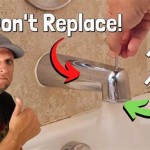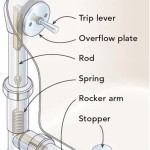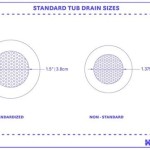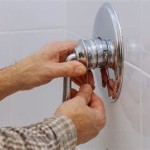How To Unclog a Bathtub Drain Full of Hair Without Vinegar
Dealing with a clogged bathtub drain is a common household issue, frequently caused by the accumulation of hair. While vinegar-based solutions are often touted, they are not always effective, particularly for severe clogs or for individuals seeking alternative methods. This article provides a detailed guide on how to unclog a bathtub drain full of hair without relying on vinegar, outlining several effective and safe techniques.
Understanding the Nature of Hair Clogs
Hair is a persistent clog culprit due to its tendency to bind together and trap other debris, such as soap scum and shampoo residue. These materials create a dense, matted mass that restricts water flow and eventually leads to a complete blockage. The location of the clog can vary, sometimes being near the drain’s surface and other times deeper within the plumbing system. Accurate assessment of the clog's severity and location will aid in selecting the most appropriate unclogging method.
Furthermore, different types of hair (e.g., human hair, pet hair) and hair lengths can contribute to the nature of the clog. Long hair is more prone to wrapping around drain components, while short hairs can accumulate and solidify into a sticky mass. Recognizing the specific characteristics of the clog can inform the unclogging strategy.
Manual Removal Techniques
Manual removal is a straightforward approach that involves physically extracting the hair clog from the drain. This method is best suited for clogs that are relatively close to the drain opening. Several tools and techniques can be employed for manual removal.
Using a Wire Hanger: A common household wire hanger can be straightened and bent at one end to create a small hook. This hook can then be carefully inserted into the drain to probe for and retrieve the hair clog. It is important to exercise caution to avoid pushing the clog further down the drain. The bent end should be rotated and manipulated to entangle the hair, allowing for gradual extraction. This process may need to be repeated several times to completely remove the obstruction.
Plunger Application: A standard cup plunger can generate suction to dislodge the clog. Ensure there is enough water in the tub to cover the cup of the plunger. Create a tight seal around the drain opening and vigorously plunge up and down for several minutes. The pressure created by the plunging action can help to loosen and break up the hair clog. Periodically check the drain to see if the water is draining more freely. If the water level decreases after plunging, it indicates that the clog is starting to break down. Repeat the process until the drain is completely clear.
Drain Snake Utilization: A drain snake, also known as a plumber's snake, is a flexible tool designed to reach deeper into the drainpipe. Insert the snake into the drain opening and rotate it to navigate through the pipes. When the snake encounters the clog, it can be used to break it apart or hook onto it for removal. Continue rotating and advancing the snake until it passes beyond the clog. Then, carefully retract the snake, removing any trapped hair. Rinse the drain with hot water to flush away any remaining debris.
Chemical Drain Cleaners: Considerations and Alternatives
While chemical drain cleaners are readily available, they often contain harsh chemicals that can damage pipes and pose environmental risks. It's crucial to consider the potential drawbacks before resorting to such products. Chemical drain cleaners can corrode metal pipes, weaken PVC pipes, and harm the environment. They also pose a safety hazard to users, requiring careful handling and ventilation. Furthermore, if the chemical drain cleaner fails to dissolve the clog, it can create a hazardous mixture with other cleaning agents or methods.
Alternatives to chemical drain cleaners include enzymatic drain cleaners. These cleaners utilize enzymes to break down organic matter, such as hair and soap scum, without harming pipes. While enzymatic cleaners are gentler than chemical drain cleaners, they may take longer to work. It is also worth noting that some enzymatic cleaners lack the strength needed to dislodge a significant hair clog.
Baking Soda and Salt Method: An alternative to vinegar, baking soda and salt can similarly create a reaction when mixed with water. Combine 1 cup of baking soda and 1/2 cup of salt and pour the mixture down the drain. Let it sit for at least 30 minutes, then flush with boiling water. Unlike vinegar, the addition of salt offers a more abrasive element that can help break down some clogs. This method is generally most effective on smaller clogs.
Advanced Techniques for Stubborn Clogs
When manual removal and alternative solutions prove insufficient, more advanced techniques may be necessary to address particularly stubborn hair clogs. These techniques often involve disassembling drain components or utilizing specialized tools.
Removing the Bathtub Drain Stopper: Many bathtubs have a drain stopper mechanism that can trap hair and debris. Disconnecting the stopper allows for direct access to the drainpipe. The type of stopper mechanism varies, but common types include lift-and-turn, push-and-pull, and pop-up stoppers. Consult the bathtub manufacturer's instructions or online resources to determine the proper method for removing the stopper. Once the stopper is removed, use a wire hanger or drain snake to extract any visible hair or debris from the drainpipe.
Inspecting the P-Trap: The P-trap is a curved section of pipe located beneath the bathtub drain. Its purpose is to trap debris and prevent sewer gases from entering the bathroom. Over time, the P-trap can accumulate hair and other materials, contributing to clogs. To clean the P-trap, place a bucket beneath it to catch any water or debris. Carefully loosen the slip nuts that connect the P-trap to the drainpipe and remove the P-trap. Thoroughly clean the P-trap by rinsing it with water and removing any accumulated hair or debris. Reassemble the P-trap, ensuring that the slip nuts are securely tightened.
Using a Wet/Dry Vacuum: A wet/dry vacuum can sometimes be used to extract clogs from a drain. Set the vacuum to its wet setting and use a narrow attachment to create a seal around the drain opening. Turn on the vacuum and attempt to suck out the clog. This method can be particularly effective for removing loose hair and debris. However, it may not be suitable for deeply embedded clogs.
Preventive Measures to Minimize Hair Clogs
Preventing hair clogs is significantly easier than dealing with them after they occur. Implementing proactive measures can minimize the accumulation of hair in the drain and reduce the frequency of clogs.
Install a Drain Screen: A drain screen or hair catcher is a simple yet effective device that fits over the drain opening. It traps hair and other debris, preventing them from entering the drainpipe. Regularly clean the drain screen to remove accumulated hair and maintain optimal drainage. Different types of drain screens are available, ranging from simple mesh screens to more elaborate designs. Choose a drain screen that is compatible with the bathtub drain and effectively traps hair.
Regular Drain Flushing: Periodically flushing the drain with hot water can help to prevent the buildup of hair and soap scum. Pour a pot of boiling water down the drain once a week to dissolve any accumulated debris. Avoid pouring boiling water down PVC pipes, as it can damage them. For PVC pipes, use hot tap water instead.
Hair Removal Practices: Implement practices to minimize the amount of hair that enters the drain. Brush hair before showering or bathing to remove loose strands. Collect hair that falls out during shampooing and dispose of it in the trash. Avoid shaving in the bathtub, as this can contribute to hair clogs. If shaving is necessary, use a shaving cream that helps to trap hair and dispose of the hair clippings in the trash.
Bi-Annual Drain Cleaning: As a preventative measure, cleaning the drain thoroughly every six months can keep major blockages from forming. This involves both manual and chemical-free methods, as well as visually inspecting the drain on a regular basis.
Avoid Overuse of Certain Hair Products: Some hair products, especially those containing oils or waxes, can contribute to clog formation. These products can coat the drainpipe and trap hair and other debris. Use these products sparingly and rinse hair thoroughly after each use.

How To Unclog A Bathtub Drain Without Chemicals

How To Unclog A Bathtub Drain Eco Friendly

Quick Tips To Unclog A Bathtub Drain Without Chemicals Plumbing Authority Inc

How To Unclog A Bathtub Drain Without Chemicals Family Handyman

How To Unclog A Bathtub Drain Without Chemicals

How To Unclog A Bathtub Drain 11 Diy Clog Busters
How To Clean The Inside Of A Bathtub Drain Without Removing It Quora

How To Easily Unclog Bathtub Shower Drain In 5 Minutes Jonny Diy

5 Ways To Clean Hair Out Of Your Shower Drain

How To Unclog Bathtub Drain Full Of Hair Clogged Unclogging








